As you shop for the perfect office chair, you are probably busy deciding between what type of leather to get or whether you should jump on the ergonomic chair bandwagon. Chances are that you haven’t given much thought to the less glamorous parts of office chairs, such as the casters. After all, how many different casters could there possibly be? The answer: plenty. With that in mind, we have compiled all the information you need to know about office chair casters into one convenient reference guide.
Full Disclaimer: We are an office furniture dealer and sell some of the products we review. To learn more about the products we sell, our review process and why you can trust us, please visit: Why we’re different. Who is BTOD.com and The Breakroom Blog?
Office Chair Caster and Wheel Links
- What are Casters?
- What to Consider When Shopping for Casters
- Parts of the Caster
- Types of Stem Styles
- How to Measure Grip Ring Stem
- Caster Sizes
- Twin Wheel vs. Single Wheel Casters
- Types of Casters
- What are Floor Glides?
1. What are Office Chair Casters?
Essentially, a caster is a wheeled device that is mounted to the bottom of each chair leg and allows the chair to easily move and roll. The basic components of any caster include the mount, stem and wheel. There may be additional parts depending on the type of caster and its intended use.
2. What to Consider When Shopping for the Right Caster
The design and construction of casters will vary according to these main factors:
- How the chair will be used
- The chair’s weight capacity
- What type of flooring the chair will be rolling across
These different considerations will dictate which caster size, material and tread are best suited for you and your needs.
Smaller wheels experience more stress during use and tend to be more difficult to roll. Larger wheels are better for frequent use and traveling over high pile carpet. Cheaply made casters don’t work to evenly distribute weight as effectively, which means that they experience wear and tend to fail. Finally, the wrong tread can actually cause damage to your floors.
3. Parts of the Caster
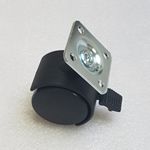
Plate Mount Casters
A plate that is bolted to the bottom of the chair leg and holds the caster in place. These are more commonly found on file cabinets and other types of office furniture.
 Office Caster/Wheel
Office Caster/Wheel
The actual wheel of the caster can be made of elastomers, nylon, steel and other materials. In some cases, the wheel is actually a ball that can roll in any direction. Office chairs typically feature a type of plastic or rubber material while more industrial, heavy-duty casters tend towards metal materials.

Office Caster Stem
Oftentimes, a stem, instead of a mounting plate, are used to attach the wheel to the leg. The stem is inserted into the chair leg and into a housing that helps keep it securely in place.
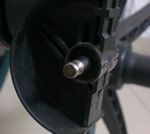
Office Caster Bushing
This component helps the caster to smoothly operate and provide an easy gliding motion. Caster maintenance can include regularly cleaning and greasing these bearings.

Office Caster Hood
Some casters feature a hood that acts as a fender to hide all the dirt and debris that the casters collect as it rolls. While it is a handy addition, it doesn’t actually contribute to the function of the caster.
4. Types of Office Caster Stem Styles

Office Caster Grip Ring
This type of caster features a stem with a groove at the top that is covered with a split steel ring, otherwise known as the grip ring. When the stem and the ring are inserted in the leg socket, the ring exerts tension outward on the rubber housing, securing the stem in place.
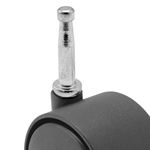
Office Caster Grip Neck
A grip neck stem features a wide base with a narrower head. When the stem is installed, the socket expands enough to let the head through and create a tight grip on the wider section of the stem. This effectively locks the stem in place.

Office Caster Threaded Stem
A threaded stem is essentially a screw that can be threaded into the socket and may be reinforced with nuts and washers.
5. How to Measure Grip Ring Stem

When you are ordering replacement casters, it is important to take accurate measurements to ensure that you get the right product the first time and don’t have to pay any return or handling fees. When it comes to measuring a grip ring stem, you will want to find the diameter of the head of the stem and the base.

A simple ruler can be placed on the top of the step to find the diameter. Most grip ring stem heads come with a diameter of 5/16” although people have a tendency to misread the ruler and order a 3/8” model. To double-check your measurements, you can compare the diameter to different size drill bits or try fitting a 5/16” wrench around the stem head. The stem base will typically measure either 7/16” or 3/8”.
6. Caster Sizes
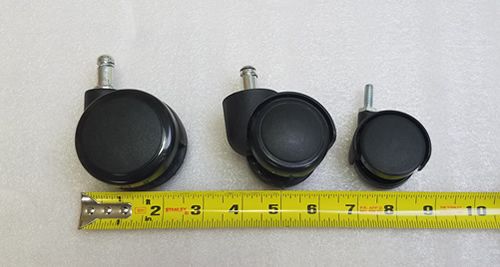
Most office chairs tend to come standard with 2” to 2.5” wheels. While this is certainly an adequate size, there are some advantages to going with larger wheels and opting for at least a 3” wheel. As you might imagine, larger wheels create less resistance when rolling and are able to more easily overcome obstacles, including high-pile carpet. Larger casters offer more durability and versatility, which means that you won’t have to worry about having to replace your casters.
7. Twin Wheel Vs. Single Wheel
Twin or dual-wheel casters are perhaps the most common caster used in office chairs. The dual caster design creates a wider surface that more effectively distributes weight, which works to prolong the life of the casters and prevent any damage to your floors. Twin casters are also unique because they can both roll and swivel, making it easy to quickly change directions while also enjoying better overall stability.
Single wheel casters, tend to be stronger than twin wheel casters simply because they have a more solid construction with fewer moving parts that can fail. For these reasons, they are typically used in more industrial applications while twin wheel options are optimal for use in office furniture.
8. Types Of Office Chair Wheels
1, Carpet Casters (standard)
Most office furniture is outfitted with carpet casters which can easily operate directly on the carpet. These casters are typically made or some sort of plastic and feature a hood.
2. Hard Surface Casters (safe on hardwood)
There are also many options that are recommended for either both carpet and hardwood floors or only hardwood floors. These models are constructed using materials that can be safely rolled across hardwood floors without causing any damage.
3. Reverse Locking Casters
Locking casters provide additional safety and functionality. These models will actually lock in place when weight is applied to the chair. Once the weight is removed, the chair can be easily rolled and moved around the room.
4. Top Plate
While the vast majority of office chairs rely on a stem system to attach casters to the chair, other heavy-duty casters are installed using a top plate mount. Essentially, the wheel is held in place with a yoke and axel and screwed to the bottom of a chair or cart through the top plate mount.
5. Floor Glides
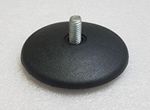
While casters are used to make sure that a chair can easily be moved, floor glides (contrary to what the name implies) work to keep chairs in place. Glides typically features a similar stem installation system. The big difference is that they consist of a metal bottom that stabilizes the chair and makes sure that is doesn’t easily slide out of place. Often times, floor glides can also be height adjusted to help deal with uneven surfaces.
While the world of casters is just as varied as the many jobs they help people execute, this guide covers many of the most popular and commonly used casters.
Additional Office Chair Resources


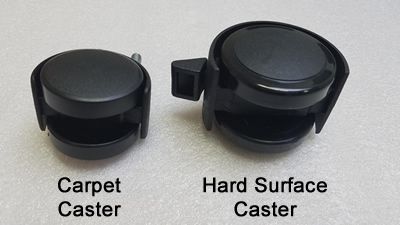



Gary R. Boss
Why can’t I find office chair casters (WITH 1 1/2 INCH STEMS)? I have looked online and in stores.
Doug Keck
Hello BTOD,
I have an old USAF office chair and the caster wheels are shot. I have removed one of the casters and the shaft diameter is 7/16 in and stem length is 1 3/8. cant find a replacement. I need four. Please send me options.
This is a special chair that belong to a wing commander who is now gone. It’s funny as an aviator people who come to my work space see this chair as an old relic. Then a fellow pilot- true aviator will come by and stand back and admire history. I want to keep this chair. Because I’m an Aviator My son is an F-15 pilot and so on… Please help.
Travis
I know it’s been 5 months, but if you’re still looking, google for the company ServiceCaster.** They have an enormous selection of all different shapes, sizes, and styles. Admittedly, I haven’t looked for the exact thing you’re looking for, but their selection is very very large, and they have a lot of “vintage” style ones that would probably be appropriate. (Note: They have a section for office chair casters, but sell all varieties. Even if not under that section, I bet there’s something on the site that’ll work.) Good luck! I have an old chair that I’m in love with as well.
**I don’t think BTOD will be upset that I mentioned another company, since they aren’t a competitor and specialize in a different type of product.
Tim Skene
The caster guide is good, but mentions only reverse locking casters. Many chair manufacturers offer locking or braking casters, which brake when the chair is empty. This is a safety feature to prevent the chair from rolling away when sitting. It’s more common than reverse locking, which is intended to immobilize the chair or stool to facilitate delicate work, such as fine assembly or surgery.